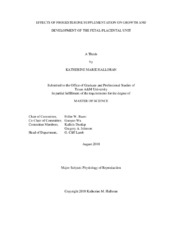| dc.description.abstract | In a previous study, administration of progesterone (P4) to ewes during the first 9 to 12 days of pregnancy has been shown to accelerate blastocyst development by Day 12 of pregnancy, likely due to P4-induced upregulation of key genes in uterine epithelia responsible for secretion of histotroph. This study determined if exogenous P4-induced acceleration of blastocyst development during the peri-implantation period affects fetal-placental development on Day 125 of pregnancy. Suffolk ewes (n=40) were mated to fertile rams and assigned randomly to receive daily intramuscular injections of either corn oil vehicle (CO, n=20) or 25 mg progesterone in CO (P4, n =20). After breeding (Day 0), treatments began on Day 1.5 and continued through Day 8 of pregnancy. Ewes from each treatment group were hysterectomized on Day 125 of pregnancy. After separating the endometrium from the chorioallantois, sections of placentomes, caruncles, cotyledons, and endometrium were processed to assess expression of mRNAs and proteins. Plasma from maternal and fetal blood was analyzed for concentrations of P4 by RIA. Samples of allantoic and amniotic fluid were obtained for analysis of glucose, fructose, amino acids, and polyamines. Volumes of the fetal fluids were measured. Fetal parameters recorded included weight, crown-rump length, abdominal and chest circumferences, and sex. Placental measurements included weight, length, and number of placentomes. There was no difference in fetal growth nor placental growth due to treatment; however, placentae of single pregnancies were longer (P<0.0001) and had more placentomes (P<0.0001) than those in twin pregnancies. qPCR analysis showed differential expression of genes between P4 and CO treated ewes in endometrium and placentomes. Low-affinity cationic amino acid transporter SLC7A2 mRNA increased (P=0.0022) in endometria of P4 treated ewes, while VEGFA and TUB were increased (P=0.0242) and decreased (P= 0.0089), respectively, in single pregnancies. In placentomes, expression of SLC2A5 and SLC2A8 mRNAs increased (P=0.0024) and (P=0.0005), respectively, in P4 treated ewes. Expression of both ACTB and TUB mRNAs increased (P=0.0019) and (P<0.0001), respectively, in placentomes of P4 treated ewes. SDHA and GAPDH were used as control genes. There was significantly more fructose than glucose in placental fluids (P > 0.05). | en |


